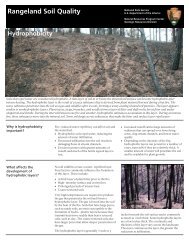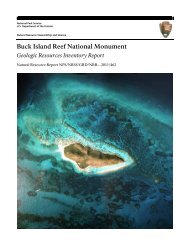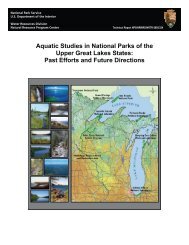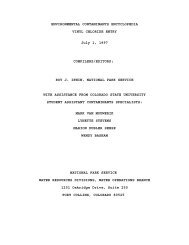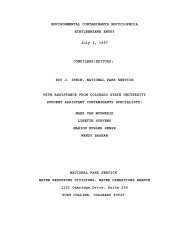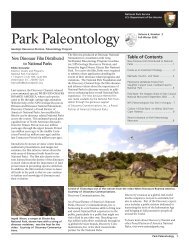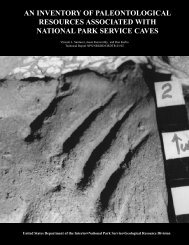MESOZOIC ROCKS Gordon B. Haxel and David M. Miller Triassic ...
MESOZOIC ROCKS Gordon B. Haxel and David M. Miller Triassic ...
MESOZOIC ROCKS Gordon B. Haxel and David M. Miller Triassic ...
You also want an ePaper? Increase the reach of your titles
YUMPU automatically turns print PDFs into web optimized ePapers that Google loves.
Mountains, where Late Jurassic diorite is known (Young <strong>and</strong> others, 1992), the mafic rocks<br />
are generally the oldest <strong>and</strong> the leucocratic rocks the youngest. Other plutons possibly in the<br />
160-165 Ma age group are in the Old Dad Mountains <strong>and</strong> Devils Playground area.<br />
Compositionally, the mafic rocks include fine- to coarse-grained gabbro, diorite, <strong>and</strong><br />
monzodiorite; common mafic minerals include clinopyroxene, hornblende, <strong>and</strong> biotite.<br />
Generally, the mafic rocks have SiO 2 contents of 49 to 55 percent; are subalkaline <strong>and</strong><br />
metaluminous; <strong>and</strong> have relatively high abundances of large-ion lithophile elements (LILE), for<br />
example commonly as much as ≈ 3 percent K 2 O <strong>and</strong> ≈1,000 ppm Ba. Young <strong>and</strong> others (1992)<br />
concluded from geochemical modelling that diorite evolved from parental magma that was<br />
derived from hydrous, REE-enriched subcontinental lithosphere <strong>and</strong> was contaminated by mafic<br />
granulite in the lower crust as it ascended to the upper crust.<br />
The mixed intrusive rocks are by far the most abundant. They are markedly<br />
heterogeneous, ranging from fine-grained equigranular to coarsely porphyritic, <strong>and</strong><br />
continuously from quartz monzodiorite to syenogranite <strong>and</strong> syenite. A number of phases or<br />
subgroups are present, typically bounded by gradational contacts. Chemically, the mixed<br />
intrusive rocks have a wide range of SiO 2 contents: 50 to 74 percent; they are subalkaline to,<br />
less commonly, alkaline; <strong>and</strong> metaluminous to weakly peraluminous. Some rocks are potassic,<br />
with K 2 O/Na 2 O as great as 2. Ba abundances are as great as 2,000 to 4,000 ppm in some of the<br />
mafic <strong>and</strong> intermediate rocks.<br />
The leucocratic monzogranite is the most homogeneous of the three rock types. Whereas<br />
other plutonic phases grade complexly into one another, the monzogranite generally cleanly<br />
cross-cuts as the youngest phase. In the Colton Hills, it comprises medium- to coarse-grained,<br />
porphyritic leucocratic biotite monzogranite, locally with minor muscovite. It is subalkaline<br />
<strong>and</strong> generally moderately peraluminous. Trace-element abundances are unremarkable.<br />
Many of the Jurassic plutonic rocks in the EMNSA are strongly altered. In the southern<br />
Providence Mountains <strong>and</strong> the southern Bristol Mountains, the rocks have undergone widespread<br />
albitization, characterized by replacement of potassium feldspar by albite (<strong>Miller</strong> <strong>and</strong> others,<br />
1985; Fox, 1989; Fox <strong>and</strong> <strong>Miller</strong>, 1990). Intense albitization is present as white zones in<br />
otherwise normally mesotype rocks. Less intense albitization produces mottled patches or<br />
spots. Chemically, albitization is characterized by doubling of Na 2 O content <strong>and</strong> nearly<br />
complete loss of K 2 O: typically K 2 O decreases from 6 percent to





